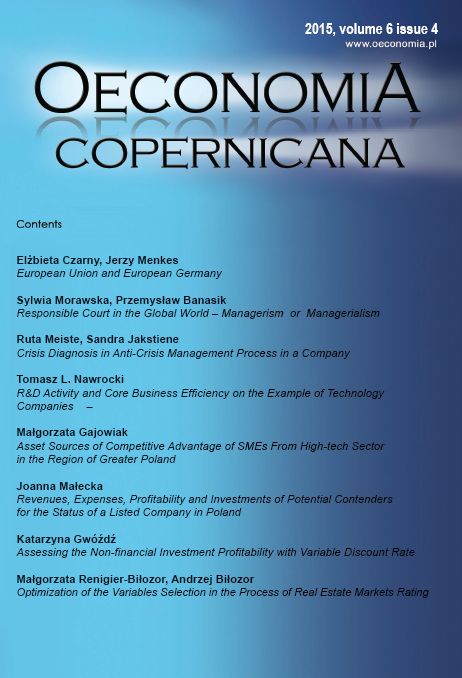R&D activity and core business efficiency on the example of technology companies
DOI:
https://doi.org/10.12775/OeC.2015.029Keywords:
research and development, core business efficiency, technology sectorAbstract
Taking as a basis for discussion the Schumpeter?s innovation theory, this paper analyses the relationship between enterprises activity in the field of research and development, and their efficiency at the core business level. This analysis was performed in two ways ? with the assumption shift in time between research and development activities and companies business efficiency, and without it ? using the Spearman?s rank correlation coefficient. The sample was accounted for 252 companies from the technology sector, whose shares are traded on NYSE or NASDAQ, and the analysis time period consisted of three years (2011?2013). The results obtained in the course of analysis generally indicate lack of strong relationship between distinguished categories. A noticeable, but only at moderate level, positive correlation was found in both considered approaches only in respect of the relationship between the intensity of expenditures on research and development or y/y change of these expenditures and gross margin on sales. Therefore, it seems to be relevant to extend this research at least in such directions as: identification and characterization of factors determining efficiency of companies research and development activities, as well as examination considered relationship taking into account business diversity within the sector and wider time shift between realized research and development activities and various measures of core business efficiency.
Downloads
References
Bednarski, L. (1979). Analiza ekonomiczna. Warszawa: PWE.
Chang, H. & Su, C. (2010). Is R&D always beneficial? Review of Pacific Basin Financial Markets and Policies, 13(1). http://dx.doi.org/10.1142/S021909151
0001809.
Feeny, F. & Rogers, M. (2003). Innovation and performance: benchmarking Australian companies. Australian Economic Review, 36(3).
Gorczyńska, A. (2010). Problem pomiaru efektywności przedsiębiorstwa. Zeszyty Naukowe Wyższej Szkoły Ekonomiczno-Społecznej w Ostrołęce, 8.
Hanel, P. & St-Pierre, A. (2002). Effects of R&D spillovers on the profitability
of companies. Review of Industrial Organization, 20(4).
Jonek-Kowalska, I. & Michalak, A. (2012). Ryzyko, koszt kapitału i efektywność
w procesie finansowania inwestycji rozwojowych w górnictwie węgla kamiennego. Warszawa: PWN.
Jonek-Kowalska, I. (2013). Różne spojrzenia na efektywność przedsiębiorstwie.
In M. Turek (Ed.). Analiza i ocena kosztów w górnictwie węgla kamiennego
w Polsce w aspekcie poprawy efektywności wydobycia. Warszawa: Difin.
Klette, T. J. (1996). R&D, scope economies, and plant performance. RAND Journal of Economics, 27(3). http://dx.doi.org/10.2307/2555841.
Lichtarski, J. (1999). Podstawy nauki o przedsiębiorstwie. Wrocław: Wydaw. AE im. O. Langego we Wrocławiu.
Morbey, G. K. (1988). R&D: Its relationship to company performance. Journal Product Innovation Management, 5(3). http://dx.doi.org/10.1111/15405885. 530191.
OECD (2002). Frascati Manual: Proposed Standard Practice for Surveys
on Research and Experimental Development. Paris: OECD Publishing.
OECD/Eurostat (2005). Oslo Manual: Guidelines for Collecting and Interpreting Technological Innovation Data. Paris: OECD Publishing. http://dx.doi.org/10. 1787/9789264192263-en.
Ramirez, P.G. & Hachiya, T. (2008). Measuring the contribution of intangibles
to productivity growth: a disaggregate analysis of Japanese firms. Review
of Pacific Basin Financial Markets and Policies, 11(2). http://dx.doi.org/ 10.1142/S0219091508001301.
Schumpeter, J. (1950). Capitalism, Socialism, and Democracy. New York: Hamper & Brothers.
Szwajca, D. (2014). Budowanie reputacji przedsiębiorstwa poprzez innowacyjność. Zeszyty Naukowe Politechniki Śląskiej, seria: Organizacja
i Zarządzanie, 74.
Tsai, K. & Wang, J. (2004). The R&D performance in Taiwan?s electronics industry: a longitudinal examination. R&D Management, 34(2). http://dx.doi.org/10.1111/j.1467-9310.2004.00332.x.
Industries classified within technology sector. Retrieved form http://biz.
yahoo.com/p/8conameu.html (20.12.2014).
Source data of analysed companies. Retrieved form http://finance.yahoo.com (20.12.2014).






